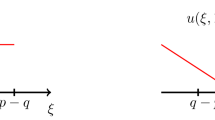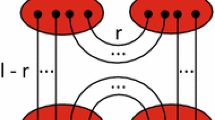Abstract
In this paper, we consider the two-species asymmetric simple exclusion process (ASEP) consisting of \(N-1\) first-class particles and one second-class particle. We assume that all particles are located at arbitrary positions but the second-class particle is the rightmost particle at time \(t=0\). We find the exact formula of the distribution of the second-class particle’s position at time t by directly using the transition probabilities of the two-species ASEP, which is a different approach from the coupling method Tracy and Widom used in [J Phys A 42:425002, 2009].
Similar content being viewed by others
Data Availability
This work is not based on data, so has no data to share.
References
Ayyer, A., Finn, C., Roy, D.: Matrix product solution of a left-permeable two-species asymmetric exclusion process. Phys. Rev. E 97, 012151 (2018)
Borodin, A., Wheeler, M.: Coloured stochastic vertex models and their spectral theory. arXiv:1808.01866
Borodin, A., Bufetov, A.: Color-position symmetry in interacting particle systems. Ann. Probab. 49(4), 1607–1632 (2021)
Chatterjee, S., Schütz, G.: Determinant representation for some transition probabilities in the TASEP with second class particles. J. Stat. Phys. 140, 900–916 (2010)
Derrida, B., Evans, M.R., Hakim, V., Pasquier, V.: Exact solution of a 1d asymmetric exclusion model using a matrix formulation. J. Phys. A 26, 1493 (1993)
Evans, M.R., Ferrari, P.A., Mallick, K.: Matrix representation of the stationary measure for the multispecies TASEP. J. Stat. Phys. 135, 217–239 (2009)
Ferrari, P.A., Kipnis, C.: Second class particles in the rarefaction front. Ann. l’Institut Henri Poincaré 31, 143–154 (1995)
Ferrari, P.A., Martin, J.B.: Stationary distributions of multi-type totally asymmetric exclusion processes. Ann. Probab. 35, 807–832 (2007)
Ferrari, P.A., Pimentel, L.: Competition interfaces and second class particles. Ann. Probab. 33, 1235–1254 (2005)
de Gier, J., Mead, W., Wheeler, M.: Transition probability and total crossing events in the multi-species asymmetric exclusion process. arXiv:2109.14232
Kuan, J.: Determinantal expressions in multi-species TASEP. Symmetry Integrab. Geom.: Methods Appl. (SIGMA) 16, 133 (2020)
Lee, E.: Distribution of a particle’s position in the ASEP with the alternating initial condition. J. Stat. Phys. 140, 635–647 (2010)
Lee, E.: Some conditional probabilities in the TASEP with second class particles. J. Math. Phys. 58, 123301 (2017)
Lee, E.: On the TASEP with the second class particles. Symmetry Integrab. Geom.: Methods Appl. (SIGMA) 14, 006 (2018)
Lee, E.: Exact formulas of the transition probabilities of the multi-species asymmetric simple exclusion process. Symmetry Integrab. Geom.: Methods Appl. (SIGMA) 16, 139 (2020)
Lee, E., Raimbekov, T.: Simplified forms of the transition probabilities of the two-species ASEP with some initial orders of particles. Symmetry Integrab. Geom.: Methods Appl. (SIGMA) 18, 008 (2022)
Mountford, M., Guiol, H.: The motion of a second class particle for the Tasep starting from a decreasing shock profile. Ann. Appl. Probab. 15, 1227–1259 (2005)
Nejjar, N.: KPZ statistics of second class particles in ASEP via mixing. Commun. Math. Phys. 378, 601–623 (2020)
Prolhac, S., Evans, M.R., Mallick, K.: The matrix product solution of the multispecies partially asymmetric exclusion process. J. Phys. A 42, 165004 (2009)
Tracy, C., Widom, H.: Integral formulas for the asymmtric simple exclusion process. Commun. Math. Phys. 279, 815–844 (2008)
Tracy, C., Widom, H.: On the distribution of a second-class particle in the asymmetric simple exclusion process. J. Phys. A 42, 425002 (2009)
Tracy, C., Widom, H.: On the asymmetric simple exclusion process with multiple species. J. Stat. Phys. 150, 457–470 (2013)
Tokebayev, Z.: The probability distribution of the species-1 particle in the two-species ASEP with initial configuration \(22\cdots 21\), MS thesis, Nazarbayev University (2022)
Acknowledgements
This paper is based on the master thesis of one of the authors [23].
Funding
This work was supported by the faculty development competitive research grant (021220FD4251) by Nazarbayev University.
Author information
Authors and Affiliations
Corresponding author
Ethics declarations
Conflict of interest
The authors declare that they have no conflict of interest.
Additional information
Communicated by Ivan Corwin.
Publisher's Note
Springer Nature remains neutral with regard to jurisdictional claims in published maps and institutional affiliations.
Appendix A: Formulas of \([\textbf{A}_{\sigma }]_{\nu _n,\nu _N}\) in (1)
Appendix A: Formulas of \([\textbf{A}_{\sigma }]_{\nu _n,\nu _N}\) in (1)
In this appendix, we briefly summarize how to find the formulas of \([\textbf{A}_{\sigma }]_{\nu _n,\nu _N}\) in (1), which were developed in [15, 16]. For a permutation \(\sigma \) in the symmetric group \({\mathcal {S}}_N\), \(\textbf{A}_{\sigma }\) is an \(N^N \times N^N\) matrix which is obtained as follows. Let \(\textrm{T}_i\) be the simple transposition which interchanges the \(i^{th}\) element and the \((i+1)^{st}\) element and leaves everything else fixed. Then, any permutation \(\sigma \in {\mathcal {S}}_N\) can be written as a product of simple transpositions, that is,
for some \(i_1,\dots , i_j \in \{1,\dots , N-1\}\). Of course, the form of (63) is not unique. For example, a permutation \((321) \in {\mathcal {S}}_3\) is written as
If \(\textrm{T}_i\) interchanges \(\alpha \) at the \(i^{th}\) slot and \(\beta \) at the \((i+1)^{st}\) slot in a permutation, that is,
we denote this \(\textrm{T}_i\) by \(\textrm{T}_i(\beta ,\alpha )\) to show explicitly which numbers are interchanged. For example,
Hence, we may have an expression
for any permutation \(\sigma \). Given \(\textrm{T}_{i}(\beta ,\alpha )\), we define \(N^N \times N^N\) matrix \(\textbf{T}_{i}(\beta ,\alpha )\) by
where \(\textbf{I}_N\) is the \(N \times N\) identity matrix and \(\textbf{R}_{\beta \alpha }\) is an \(N^2 \times N^2\) matrix, where \(\textbf{R}_{\beta \alpha }\) is defined as follows. Let us label all columns and rows of \(N^2 \times N^2\) matrices by ij where \(i,j =1,\dots , N\) in the lexicographical order. The (ij, kl) entry of the matrix \(\textbf{R}_{\beta \alpha }\) is defined to be
where
Now, for a given expression (64), define
It is a known fact that \(\textbf{A}_{\sigma } \) is well-defined in the sense that (65) represents the same matrix for any expression (64). We have just constructed an \(N^N \times N^N\) matrix \(\textbf{A}_{\sigma }\) for a given permutation \(\sigma \). Now, let us label all columns and rows of \(\textbf{A}_{\sigma }\) by \(\nu =i_1\cdots i_N\) where \(i_j \in \{1,\dots , N\},\, j=1,\dots , N\) in the lexicographical order. In this paper, we denote \(2\cdots 212\cdots 2\) by \(\nu _n\) if 1 is the \(n^{\textrm{th}}\) leftmost number.
Since \(\textbf{A}_{\sigma }\) is a product of matrices, in general, the matrix elements \([\textbf{A}_{\sigma }]_{\pi ,\nu }\) are possibly written as a sum of the products of the matrix elements of \(\textbf{T}_{i_j}(\beta _j,\alpha _j),\dots , \textbf{T}_{i_1}(\beta _1,\alpha _1)\) in (65). However, it was shown in [16] that, for some special cases of initial order of particles \(\nu \), \([\textbf{A}_{\sigma }]_{\pi ,\nu }\) are expressed as a product of the matrix elements of \(\textbf{T}_{i_j}(\beta _j,\alpha _j),\dots , \textbf{T}_{i_1}(\beta _1,\alpha _1)\), not a sum of the products. In particular, for the initial order of particles \(\nu _N\), that is, \(2\cdots 21\), the formulas \([\textbf{A}_{\sigma }]_{\nu _n,\nu _N}\) are given in Theorem 1.2 (a), Theorem 1.4, Theorem 1.6, Theorem 1.7, and Proposition 1.8 in [16].
Rights and permissions
Springer Nature or its licensor (e.g. a society or other partner) holds exclusive rights to this article under a publishing agreement with the author(s) or other rightsholder(s); author self-archiving of the accepted manuscript version of this article is solely governed by the terms of such publishing agreement and applicable law.
About this article
Cite this article
Lee, E., Tokebayev, Z. Distribution of a Second-Class Particle’s Position in the Two-Species ASEP with a Special Initial Configuration. J Stat Phys 190, 76 (2023). https://doi.org/10.1007/s10955-023-03085-8
Received:
Accepted:
Published:
DOI: https://doi.org/10.1007/s10955-023-03085-8




